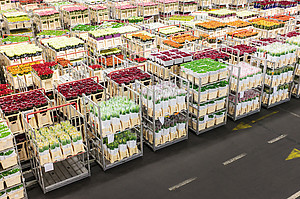Dutch Flower Auctions
Transforming a century-old tradition of selling with analytics
Every day a deluge of flowers finds their way through Royal FloraHolland auction centres throughout the Netherlands. Within hours they are sold and shipped to locations all over the world. The auction house embraces traditions going back more than a century, and its methods have changed little. In order to innovate based on hard facts combined with intuition, Professors Eric van Heck and Wolfgang Ketter of the Rotterdam School of Management (RSM) and members of the LIS programme were asked to carry out an objective study on the future of the auction centres’ clock system.
“The results so far are really insightful and help us to develop smart real-time decision support systems.”
– Theo Aanhane, Manager of Auctioning & Quality Systems, Flora Holland

The Dutch auction method serves to achieve the highest possible price within the shortest possible time, ideal when dealing with a perishable product such as cut flowers. The auctioneer begins each sale with a predetermined highest asking price, lowering it until a bid is made or a reserve price is reached. Prices are shown on a clock and buyers typically have mere seconds to make a decision. They would often have to rely solely on their intuition to make these decisions. Royal FloraHolland has had a long-standing relationship with Rotterdam School of Management, and the need to estimate prices for each auction is what led them into a discussion with Eric van Heck and Wolfgang Ketter. Together they investigated the Aalsmeer auction and its role in the next generation of markets, which will be increasingly affected by novel and fast-paced developments in digitizing information with technology. The resulting research combined the insight of auctioneers with the possibilities of Big Data analytics to allow the auction cooperative to better inform their decision making in real time and thus achieve higher efficiency and revenues. Initially, data on past bidding was analysed in order to cluster buyers into various broad categories. This allowed auctioneers to build an overview of the bidders’ general types of behaviour, and so better decide on how to set auction parameters, such as starting price and minimum purchase quantity. This allowed them to optimise the profitability and efficiency of a particular auction day.2
Alternative scenarios were investigated to see what happens when parameters are modified, so that alternative policy scenarios could be tested. Such laboratory and field experiments proved very insightful and beneficial to all parties involved: Royal FloraHolland was able to better see the real-world effects of their decisions, and researchers gained access to vast amounts of real world data and the knowledge of industry experts. New experiments are still ongoing. Van Heck and Ketter, together with their team of PhD students, are currently looking into the effects of removing the ID of the bidder from the auctioning process and looking into ‘multi-transaction’ auctioning. Both indicate a substantial impact on prices for the auction as well as for buyers.3
Based on the analyses, auctioneers were able to make faster decisions and better tailor the auction to the buyers present. This resulted in the auction being able to clear out, on average, 25 minutes earlier each day. Thus, flowers sold could be shipped off sooner to their customers. It also offers the possibility to auction off more flowers in the current time scheduled; thus, more buyers can obtain the flowers they need. This is particularly crucial during peak times around holidays. With the current analytics provided by ERIM, the potential additional profit for the auction house has been substantial.
Developing smart, real-time decision support systems is not limited to auctioneers. The researchers now work on similar systems for growers. There are additional plans to devise such support for bidders as well. The use of intelligent software agent technology can be implemented across the entire supply chain. The end goal is a very competitive supply chain in the world of cut flowers. Meanwhile, end customers also benefit from the process: more flowers make it to the market faster, resulting in more choice and fresher flowers.
2 Lu, Y., A. Gupta, W. Ketter, and E. van Heck. 2016, Exploring Bidder Heterogeneity in Multichannel Sequential B2B Auctions, MIS Quarterly, 40(3), 645-662, September 2016.
3 Lu, Y., A. Gupta, W. Ketter, and E. van Heck. “Information Transparency in B2B Sequential Auctions”
Conference on Information Systems and Technology (CIST), San Francisco, USA, November, 2014. Best
Video Presentation Nomination.
Lu, Y., A. Gupta, W. Ketter, and E. van Heck. “Applying Structural Econometric Analysis to B2B Sequential Dutch Auctions,” Conference on Information Systems and Technology (CIST), Minneapolis, USA, October, 2013. Best Student Paper Nomination.
Lu, Y., A. Gupta, W. Ketter, and E. van Heck. “Exploring Bidder Heterogeneity in B2B Auctions: Evidence from the Dutch Flower Auctions,” Conference on Information Systems and Technology (CIST), Phoenix, USA, October, 2012. Best Student Paper Nomination.
Source: ERIM Self Assessment Report 2010 – 2015, January 2017


